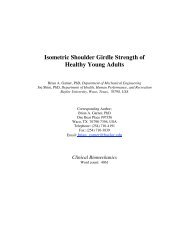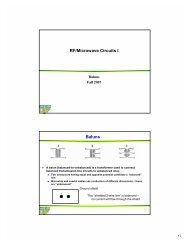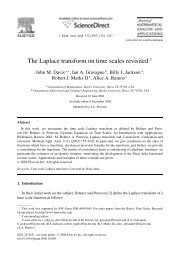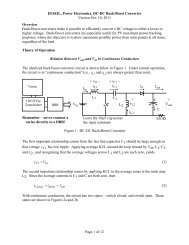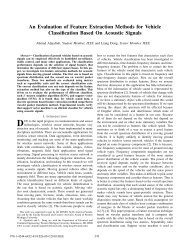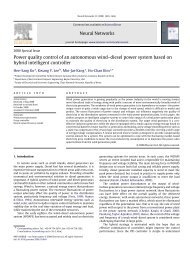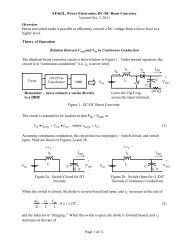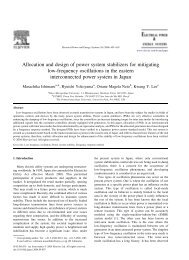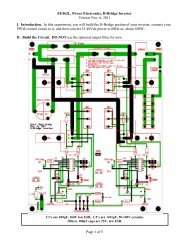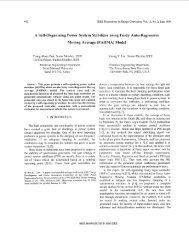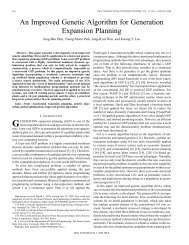Notes on Nodal Analysis, Prof. Mack Grady, June 4, 2007 ... - ECS
Notes on Nodal Analysis, Prof. Mack Grady, June 4, 2007 ... - ECS
Notes on Nodal Analysis, Prof. Mack Grady, June 4, 2007 ... - ECS
You also want an ePaper? Increase the reach of your titles
YUMPU automatically turns print PDFs into web optimized ePapers that Google loves.
<str<strong>on</strong>g>Notes</str<strong>on</strong>g> <strong>on</strong> <strong>Nodal</strong> <strong>Analysis</strong>, <strong>Prof</strong>. <strong>Mack</strong> <strong>Grady</strong>, <strong>June</strong> 4, <strong>2007</strong>Definiti<strong>on</strong>sNode:Branch:A point or set of points at the same potential that have at least two branchesc<strong>on</strong>nected to them.A circuit element that c<strong>on</strong>nects nodes.Major Node: A node with three or more branches c<strong>on</strong>nected to it.Super Node: Two major nodes with an ideal voltage source between them.Reference Node: The node to which all other node potentials are referenced. The relativevoltage of the reference node is zero.Soluti<strong>on</strong> Procedure1. Draw a neat circuit diagram and try to eliminate as many branch crossings as possible.2. Choose a reference node. All other node voltages will be referenced to it. Ideally, itshould be the node with the most branches c<strong>on</strong>nected to it, so that the number of terms inthe admittance matrix is minimal.3. If the circuit c<strong>on</strong>tains voltage sources, do either of the following:• C<strong>on</strong>vert them to current sources (if they have series impedances)• Create super nodes by encircling the corresp<strong>on</strong>ding end nodes of each voltage source.4. Assign a number to every major node (except the reference node) that is not part of asuper node (N1 of these).5. Assign a number to either end (but not both ends) of every super node that does not touchthe reference node (N2 of these)6. Apply KCL to every numbered node from Step 4 (N1 equati<strong>on</strong>s)7. Apply KCL to every numbered super node from Step 5 (N2 equati<strong>on</strong>s)8. The dimensi<strong>on</strong> of the problem is now N1 + N2. Solve the set of linear equati<strong>on</strong>s for thenode voltages. At this point, the circuit has been “solved.”9. Using your results, check KCL for at least <strong>on</strong>e node to make sure that your currents sumto zero.9. Use Ohm’s Law, KCL, and the voltage divider principle to find other node voltages,branch currents, and powers as needed.EE411, Fall2011, Week2, Page 1 of 31
<strong>Grady</strong>, Admittance Matrix and the <strong>Nodal</strong> Method, <strong>June</strong> <strong>2007</strong>, Page 2where Y is the admittance matrix, V is a vector of bus voltages (with respect to ground), and I is avector of current injecti<strong>on</strong>s.Voltage sources, if present, can be c<strong>on</strong>verted to current sources using the usual network rules. Ifa bus has a zero-impedance voltage source attached to it, then the bus voltage is already known,and the dimensi<strong>on</strong> of the problem is reduced by <strong>on</strong>e.A simple observati<strong>on</strong> of the structure of the above admittance matrix leads to the following rulefor building Y:1. The diag<strong>on</strong>al terms of Y c<strong>on</strong>tain the sum of all branch admittances c<strong>on</strong>nected directly to thecorresp<strong>on</strong>ding bus.2. The off-diag<strong>on</strong>al elements of Y c<strong>on</strong>tain the negative sum of all branch admittances c<strong>on</strong>necteddirectly between the corresp<strong>on</strong>ding busses.EE411, Fall2011, Week2, Page 4 of 31
<strong>Grady</strong>, Admittance Matrix and the <strong>Nodal</strong> Method, <strong>June</strong> <strong>2007</strong>, Page 3These rules make Y very simple to build using a computer program. For example, assume thatthe impedance data for the above network has the following form, <strong>on</strong>e data input line per branch:From To Branch Impedance (EnteredBus Bus as Complex Numbers)1 0 ZE1 2 ZA2 0 ZB2 3 ZC3 0 ZDThe following FORTRAN instructi<strong>on</strong>s would automatically build Y, without the need ofmanually writing the KCL equati<strong>on</strong>s beforehand:COMPLEX Y(3,3),ZB,YBDATA Y/9 * 0.0/1 READ(1,*,END=2) NF,NT,ZBYB = 1.0 / ZBC MODIFY THE DIAGONAL TERMSIF(NF .NE. 0) Y(NF,NF) = Y(NF,NF) + YBIF(NT .NE. 0) Y(NT,NT) = Y(NT,NT) + YBIF(NF .NE. 0 .AND. NT .NE. 0) THENC MODIFY THE OFF-DIAGONAL TERMSY(NF,NT) = Y(NF,NT) - YBY(NT,NF) = Y(NT,NF) - YBENDIFGO TO 12 STOPENDOf course, error checking is needed in an actual computer program to detect data errors anddimensi<strong>on</strong> overruns. Also, if bus numbers are not compressed (i.e. bus 1 through bus N), thenadditi<strong>on</strong>al logic is needed to internally compress the busses, maintaining separate internal andexternal (i.e. user) bus numbers.Note that the Y matrix is symmetric unless there are branches whose admittance is directi<strong>on</strong>dependent.In AC power system applicati<strong>on</strong>s, <strong>on</strong>ly phase-shifting transformers have thisasymmetric property. The normal 30 o phase shift in wye-delta transformers creates asymmetry.EE411, Fall2011, Week2, Page 5 of 31
EE411, Fall2011, Week2, Page 6 of 31
EE411, Fall2011, Week2, Page 7 of 31
EE411, Fall2011, Week2, Page 8 of 31
EE411, Fall2011, Week2, Page 9 of 31
<strong>Grady</strong>, Admittance Matrix and the <strong>Nodal</strong> Method, <strong>June</strong> <strong>2007</strong>, Page 6A simple FORTRAN computer program for solving V in an N-dimensi<strong>on</strong> problem usingGaussian eliminati<strong>on</strong> and backward substituti<strong>on</strong> is given below.COMPLEX Y(N,N),V(N),I(N),YMMC GAUSSIAN ELIMINATE Y AND INM1 = N - 1C PIVOT ON ROW M, M = 1,2,3, ... ,N-1DO 1 M = 1,NM1MP1 = M + 1YMM = 1.0 / Y(M,M)C OPERATE ON THE ROWS BELOW THE PIVOT ROWDO 1 J = MP1,NC THE JTH ROW OF II(J) = I(J) - Y(J,M) *YMM * I(M)C THE JTH ROW OF Y, BELOW AND TO THE RIGHT OF THE PIVOTC DIAGONALDO 1 K = M,NY(J,K) = Y(J,K) - Y(J,M) * YMM * Y(M,K)1 CONTINUEC BACKWARD SUBSTITUTE TO SOLVE FOR VV(N) = I(N) / Y(N,N)DO 2 M = 1,NM1J = N - MC BACKWARD SUBSTITUTE TO SOLVE FOR V, FORC ROW J = N-1,N-2,N-3, ... ,1V(J) = I(J)JP1 = J + 1DO 3 K = JP1,NV(J) = V(J) - Y(J,K) * V(K)3 CONTINUEV(J) = V(J) / Y(J,J)2 CONTINUESTOPENDEE411, Fall2011, Week2, Page 13 of 31
EE411, Fall2011, Week2, Page 15 of 31
EE411, Fall2011, Week2, Page 16 of 31
EE411, Fall2011, Week2, Page 17 of 31
EE411, Fall2011, Week2, Page 18 of 31
EE411, Fall2011, Week2, Page 19 of 31
EE411, Fall2011, Week2, Page 20 of 31
EE411, Fall2011, Week2, Page 21 of 31
EE411, Fall2011, Week2, Page 22 of 31
EE411, Fall2011, Week2, Page 23 of 31
EE411, Fall2011, Week2, Page 24 of 31
EE411, Fall2011, Week2, Page 25 of 31
EE411, Fall2011, Week2, Page 26 of 31
EE411, Fall2011, Week2, Page 27 of 31
EE411, Fall2011, Week2, Page 28 of 31
EE411, Fall2011, Week2, Page 29 of 31
EE411, Fall2011, Week2, Page 30 of 31
EE411, Fall2011, Week2, Page 31 of 31



